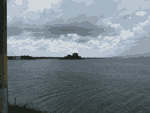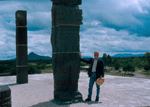Homework #2 Pre-Columbian humanities: Mayas, Uxmal, Tikal, Olmecs, Toltecs |
Q1. |
Knowing that Lake Petén Itzá (see: => Petén in the Index) is the place in Guatemala where the Mayan civilization began, do the following: (A) study the 12 image of Dr. Little's virtual tour of the region; then (B) choose and study two of the images that show a sharp contrast in terms of scene and content; finally, (C) succinctly compare and contrast the two image you choose to discuss. How do the two images you choose enrich or confuse your understanding of Latin American humanities?
|
|
Q2. |
Succinctly compare and contrast Temple #1 at Tikal with the Pyramid of the Magician (la Pirámide del Adivino) at Uxmal. |
|
Q3. |
(A) Identify the major humanities artifact of the "mother
culture" of Mesoamerica. (B) Describe it. (C) Speculate on how this
particular pre-Aztec artifact “sets up” a symbolic or actual starting
point, a point of departure, or touchstone for the trajectory of
Mesoamerican (that is, cultures north of the Mayan region) humanities that
follows this “mother culture.” On the other hand, if you think this
particular artifact is so out of context, so extraneous to Mesoamerican
humanities and culture, say so, and say why you think it is not, in fact, a
significant starting point.
|
|
Q4. |
||
Q5. |
Study the image and the commentary on page 7 in the series on the Museo Nacional de Antropología. (A) What "humanities questions" would you append to this page? (B) In addition, answer the two question shown on page 7. |
|
Q6. |
In this passage in the part of the Popol Vuh that is assigned reading for HUM2461, we read this passage: "And in this way the sons of Vucub-Caquix proclaimed their pride. "Listen! I am the sun!," said Vucub-Caquix. "I am he who made the earth!" said Zipacná. "I am he who shook the sky and made the earth tremble!" said Cabracán. In this way the sons of Vucub-Caquix followed the example of their father's assumed greatness. And this seemed very evil to the youths." (A) Who are these "youths," what are their names. (B) It would seem that the sun and the maker of the earth would be good; so why do the youths find them bad, and what happens? |
|
Q7. |
Study the image and the commentary on page 3 in the series on the Museo Nacional de Antropología. Page #3 involves both the past and the present. Assuming that culture functions to dynamically and organically to (a) interpret the past, (b) cope with the present, and (c) create the future, (A) how do you see all three--that is "a", "b" and "c" fused into this image? And (B) what about the fifth volador at the top and out of the frame of the humanities artifact that is the photo itself? What does he have to do with the culture shown in this image? |
|
Q8. |
In Chapter 1 in the Popol Vuh, Gucumatz is one god, but he also has two personalities. (A) What are these two aspects of Gucumatz? (B) What Aztec god does Gucumatz correspond to? (C) What are the three aspects of Huracán/Heart of Heaven? (D) What does Gucumatz (in two persons) plan to do, and what does he/do they actually create? |
|
Q9. |
(A) In Chapter 7 of the Popol Vuh , how does Zipacná escape from being killed by the 400 boys? (B) How did the 400 boys perish? |
|
Q10. |
In Chaper 9, Hunahpú and Xbalanqué defeat Cabracán. Knowing that the Popol Vuh is a sacred or religious book about the origins of the cosmos and the earth, what is the religious or cosmological level of meaning in the story of Cabracán's defeat? How do the realistic and descriptive details in this story support or undermine your thoughts about the "higher level" of meaning in this story? Be succinct and brief. |
|
Q11. |
Study the following figurine found in the Mayan Art Index. (A) Describe it in some detail in your own words. (B) In what way does this object of the humanities combine realism, mythology/religion, and art? (C) In your opinion is it beautiful or attractive? Why? |
|
Q12. |
(A) What do the following terms/place names refer to: (1) Petén Itzá; (2) Chichén Itzá; (3) Utatlán (Q'umarkaj); and (4) Tula? (B) What is the chronological and geographical relationship between these terms? |
|
|
(A) Identify this humanities object (what, where, meaning);
(B) Compare and contrast it to Stela H in Copán.
|
|
Q13. |
Discuss briefly the opposition between Topiltzin-Quetzalcóatl and Tezcatlipoca. |
|
Q14. |
One of the seemingly minor aspects of Pre-Columbian history and humanities is Cuicuilco. After studying the few images of Cuicuilco and reading the comments, how important do you think this seemingly obscure site is to Latin American (especially Mesoamerican) humanities? Explain briefly. |
|
Q15. |
(A) Define the key term "syncretism" in your own words. (B) Give an example and describe it in terms of something that has been presented in the course from the origins of Latin American humanities up to the Aztecs. |






